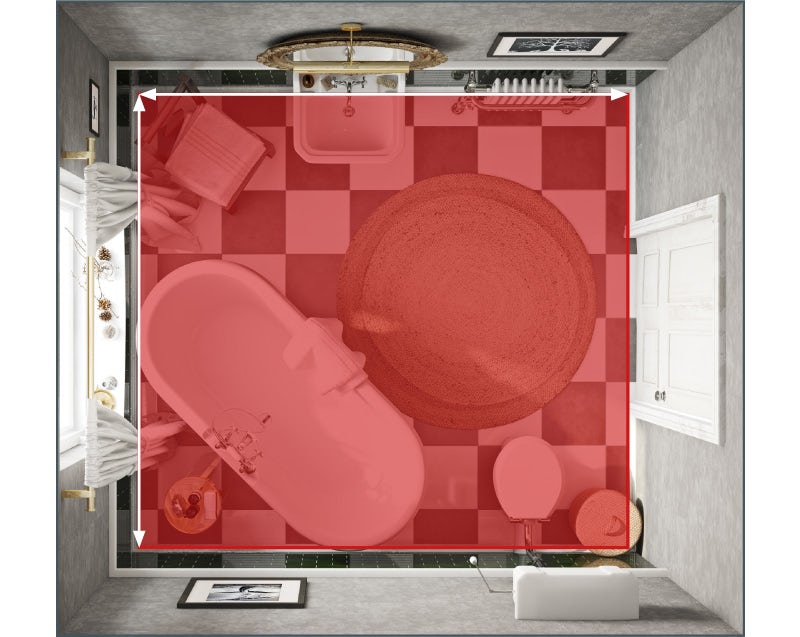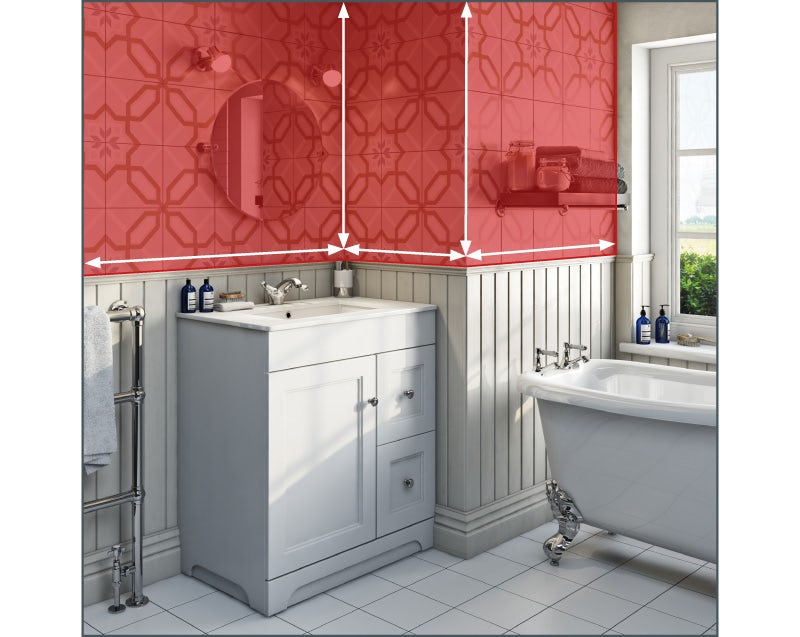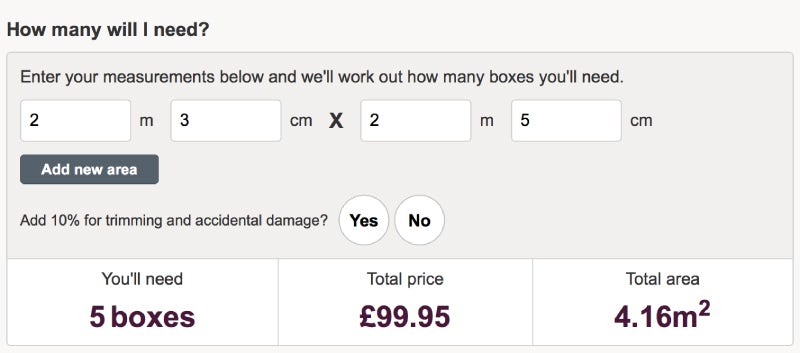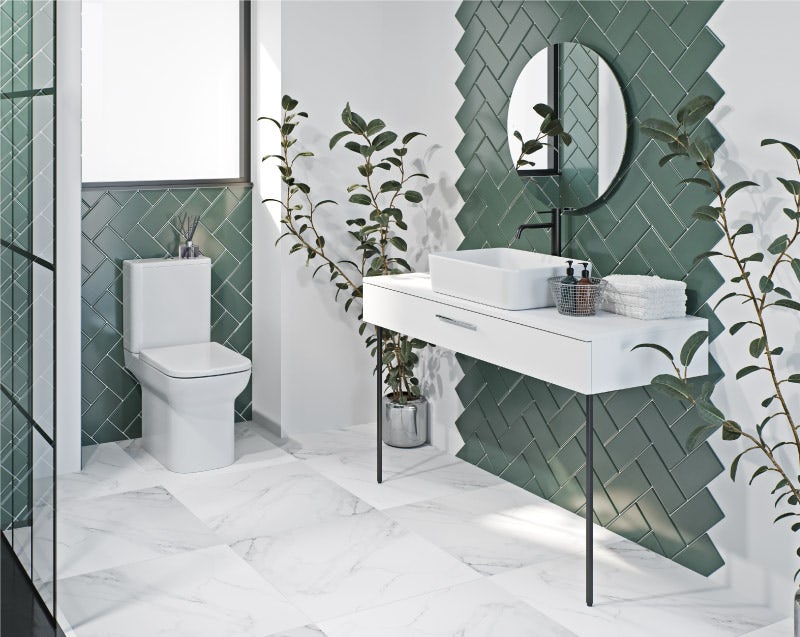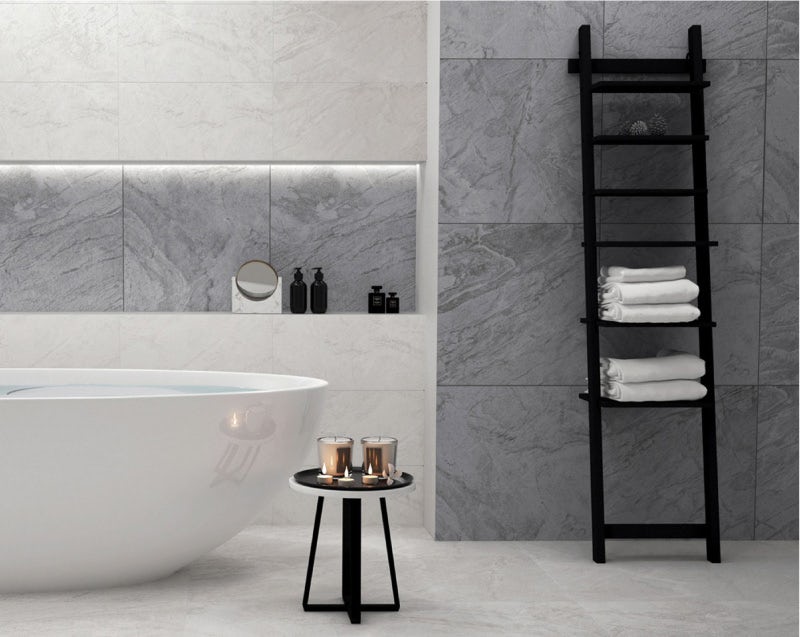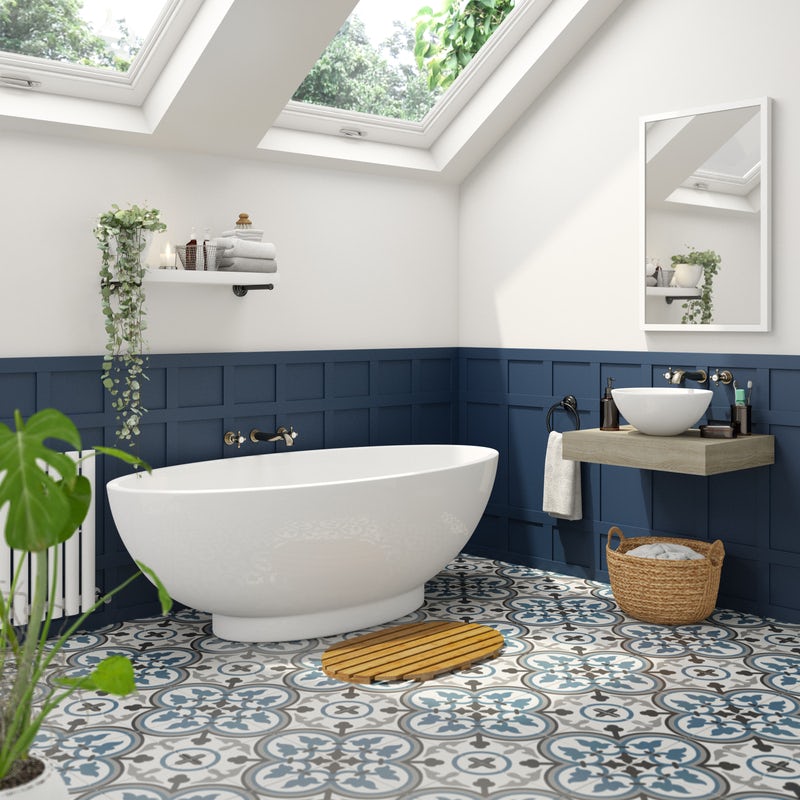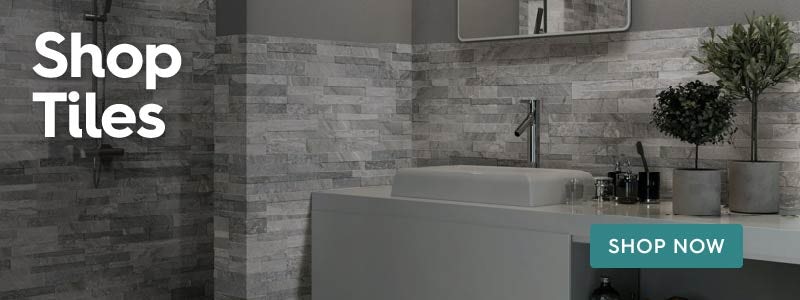Tiles are one of the most popular wall and floor coverings in bathrooms and kitchens. In this expert guide, we’ll explain everything you need to know about kitchen and bathroom tiles before you buy.
If you’ve decided to go ahead and choose tiles for your kitchen or bathroom project, you’ll find loads of great advice and information in this comprehensive tile buying guide. Simply click on any of the links below to skip ahead to a relevant topic.
However, if you already have a good idea of the type of tiles you want, why not browse our huge range of bathroom and kitchen tiles now?
1. Why tiles?
Thanks to their hardwearing nature and stylish appearance, tiles are one of the most popular walls and floor coverings for bathrooms and kitchens—even finding their way into other areas of the home.
Of course, there are many other reasons why tiles are commonly found in homes up and down the UK, including their water-resistant properties which make them ideal for splash zones, not to mention versatility and cost factors.
So, if you’ve decided that tiles are the right choice for your bathroom or kitchen project, yet simply aren’t sure where to begin, we’ve come up with a few considerations you’ll need to make, right from the start.
Tiles form the perfect backdrop to any bathroom or kitchen
2. General info on tiles
Wall and floor tiles
If you’re fitting tiles to your floors, these will need to be slightly stronger than wall tiles, due to the amount of wear and tear they experience. When shopping, all our tiles are clearly indicated as either “wall tiles” (suitable for walls only) or “wall and floor tiles” (suitable for both).
Gloss or matt finish?
Generally, tiles come with either a gloss or matt finish. Which one you choose is down to personal taste.
- Gloss—a reflective surface that enhances light and creates the illusion of space
- Matt—perfect for an understated finish, plus marks and stains show up less
Suitability for wet rooms and underfloor heating
Only certain tiles are suitable for use with wet rooms and/or underfloor heating. So, if you are buying with either of these intentions in mind, make sure you check before you purchase.
Tile texture
Most of our tiles are flat, however, if you’d prefer to add texture to your bathroom or kitchen design, you’ll find plenty of choices, including bevelled metro tiles, artisan-style bumpy tiles, contemporary split face designs and more.
Anti-slip rating
Tiles are given what’s called an “R rating” for anti-slip properties. The rating system begins at R9, which is the lowest degree of slip resistance to R13, which is the highest. If you’re fitting tiles to a bathroom floor used by elderly people or young children, it’s worth seeking out tiles with a higher R rating. For more information, read our guide to anti-slip tiles.
Rectified tiles
A rectified tile is where the tile is cut after the baking process, producing clean, crisp edges, meaning only a minimal grout line is required.
Tile samples
It’s always great to try before you buy, isn’t it? Which is why you’ll be pleased to know that you can order up to 3 tile samples from us. Simply click “Add sample” when on the tile product page.
3. Tile installation
If you’re renovating an existing bathroom or kitchen which already contains old tiles, you’ll first need to work out what you’re going to do with them. If you’re planning on keeping some of them, you may want to consider how any new tiles, ceramics or furniture will fit with them.
Handy hint: Find out what the experts say about tiling on top of existing tiles.
One other thing to remember is you may wish to order slightly more tiles than you need. This allows for any breakages which might occur during the tiling process, whilst providing you with spares, should you need to replace fittings like your toilet, basin or shower in the future.
Measuring for tiles
The most common way to buy tiles is by working out total required coverage in square metres (m²).
To find out what coverage you need, start by measuring the floors and walls you wish to tile. If you’re tiling the floor, start by measuring the length and width of the total area, then multiply the 2 measurements together. If you have an irregular shaped room (for example, an L shape or T shape), it’s easier to split it up into rectangles and measure each one separately.
Measuring walls is relatively straightforward. Simply work out how wide your wall is and how far up the wall you wish to tile. Multiply these 2 measurements to get the total square metre coverage for your wall. Do the same for any other walls and add these totals together.
The areas around your windows and doors can prove difficult, so it’s always best to allow an extra 10% on top of what you’ve measured.
Using a tile calculator
To make life easier, we’ve included a tile calculator on each of our tile product pages. Simply add the measurements of each area you wish to tile, add your optional 10% on, and it’ll show you exactly how many boxes you’ll need, how much it will cost and what the total coverage is in metres squared.
How to fit tiles
If you’re a DIY enthusiast or simply wish to save a bit of money by tiling yourself, you’ll find all the help and advice you’ll need in our how to tile guide, which includes expert videos and step-by-step instructions.
4. Which tile material?
When picking out your tiles, there are a range of materials you can choose from, including glass, porcelain and ceramic. As ceramic and porcelain are by far the most common, let’s examine these in greater detail.
Ceramic v Porcelain
Both ceramic and porcelain tiles are manufactured in much the same way. Natural clay is cut into shapes and baked at a high temperature before a patterned glaze is added.
However, where the manufacturing process differs is that ceramic tiles use brown, red or white clay, whereas porcelain exclusively uses white clay. Other elements, including sand and feldspar, are added into the mixture, before being subjected to higher temperatures than ceramic tiles. This results in a harder more rigid tile that is even more waterproof. It is this porous nature which determines whether a clay tile is classified as ceramic or porcelain.
To check, a tile is weighed before being submerged in water. If the tile weighs an extra 0.5% after being removed from the water, it has absorbed some of the water and will be classified as a ceramic tile. If not, it is classified as a porcelain tile.
The best tiles for splash zones
As you can already tell, with a less porous nature, porcelain tiles are more suitable for splash zones like the internal walls of your shower enclosure or a kitchen floor, and do a more effective job in protecting walls and floors from water ingress. However, that is not to say that ceramic tiles won’t perform a similar task.
The best tiles for wear and tear
As they’re harder than their ceramic counterparts, porcelain tiles offer greater resistance to abrasion and general wear and tear. This makes them ideal for bathroom and kitchen floors, as well as in areas of high footfall like hallways and conservatories. Again, ceramic tiles can be used but, over time, there is a greater chance of chips, scuffs and stains occurring.
5. Caring for your tiles
As with anything in life, the more you care for the tiles, the better they’ll serve you and the longer they’ll last.
Sealing tiles
If you’ve chosen porcelain or ceramic tiles, these won’t need to be sealed after installation. However, some natural stone tiles may require sealing to prevent the porous surface from staining and to protect your walls and floors from water ingress. If you have selected a material other than ceramic, porcelain or glass, carefully check whether you need to seal your tiles beforehand.
How often should tiles be resealed?
With natural tiles, you will need to reseal every 6 months to ensure they remain watertight. Seek out specialist cleaning materials and polish to keep natural stone looking fresh.
Aftercare
Once you’ve fitted your tiles, you should regularly maintain your tiles to keep them at their very best.
Make sure you wipe up any spills or this could stain your tiles or, at worst, cause an injury due to slipping. If you have floor tiles in a bathroom or kitchen, it’s a good idea to put an absorbent mat down where water splashes could occur.
For more care tips, check out our guide on how to clean tiles.
Check the maintenance guide that comes with your tiles for more specific instructions.
6. How to be creative with tiles
One of the main things people struggle with, when searching for tile inspiration, is how to be creative with their tiles. With some of our tips below, we’ll show you just how easy it is to get the look you want, resulting in walls and floors which give your room a unique character and complement the rest of your décor perfectly.
First off, why not consider patterned tiles? They offer a quick and effective way to add interest to your design. However, there are some equally creative ways to use single colour tiles and we’ll explore these in the next section.
Patterns and designs
One of the great things about tiles is the many different ways they can be installed.
LINEAR
The most common type of pattern is a linear design, whereby all grout lines are neatly lined up to form a uniform look.
DIAMOND
A variation on this theme is to tilt your tiles by 45°, resulting in a diamond pattern. Whilst this still produces a more uniform look, it certainly produces a more intriguing effect.
BRICK BOND
Brick bond is the name given to a style of tiling which closely resembles the way bricks are laid. Rows of horizontal tiles are positioned so the vertical grout lines appear at the halfway mark of the tile immediately above and below. This is an especially popular method for metro tiles.
¾ BRICK BOND
A variation on this style, a ¾ brick bond pattern means, instead of being halfway along the tile immediately above and below, the vertical grout line appears three quarters of the way along instead.

HERRINGBONE 90°/45°
Whilst slightly more complicated, a herringbone pattern uses a mix of vertical and horizontally placed tiles and can produce an incredible look, especially where different coloured tiles are combined. To produce a zig-zag pattern, rotate by 45°.
MIXED LINEAR
By cutting your tiles to different sizes or using tiles of varying length, you can create this stunning mixed linear pattern.
MIXED SIZE PATTERN
As well as using tiles of varying length, you can also use tiles of mixed size to create a unique pattern.
BASKET WEAVE 90°/45°
By placing three horizontal tiles next to three vertical tiles and forming squares, you can create this beautiful basket weave pattern. A variation on this is to rotate the whole design by 45°.
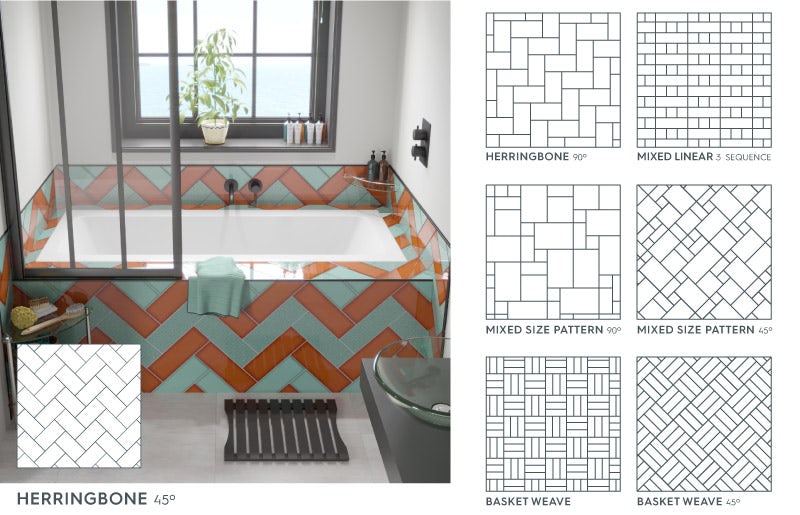
Finishing touches
As well as your tiles, there are other ways to add unique finishing touches to your tiles. For example, to help white tiles stand out more, you could use a black or grey grout. Plus, for edges (e.g. external corners and around windows), why not add a tile trim which come in a variety of colours and finishes.
Different tile styles
Of course, there are many different tile styles which may fit well with your chosen bathroom or kitchen design. Below, we’ve listed some of the main styles you can choose.
Metro tiles
So-called as they were primarily used in underground and subway stations in the early part of the 20th century, metro tiles are small in size and often come with bevelled edges. They are incredibly popular for both bathrooms and kitchens due to their versatility.
Brick tiles
Brick tiles are very similar in size and shape to metro tiles, although they don’t usually come with a bevelled edge.
Stone effect tiles
Another big trend in home interiors is the organic look. Stone effect tiles are designed to look just like the real thing. You can even choose slate effect tiles and marble effect tiles for a touch of luxury.
Wood effect tiles
Wood effect tiles are a great way to replicate the look of wood flooring without using the real thing, which isn’t usually suitable for bathrooms and kitchens.
Traditional or Victorian tiles
If you’re looking to create a vintage-inspired bathroom or kitchen, traditional or Victorian tiles are a great way to continue this theme. However, even when used in a contemporary setting, traditional tiles can help produce amazing feature floors and walls.
Tile ideas
Head to our tile image gallery for lots of great ideas for your tiling project or simply click on one of the articles below to get creative.
- Bathroom tiling ideas
- 10 beautiful bathroom floor tiles
- 5 exciting and unusual ways to use tiles in your bathroom
- 6 more bathroom tile ideas that'll capture your imagination
- 8 different ways to use metro tiles
7. Further advice on tiles
If you need further help and advice when it comes to choosing tiles or attempting tiling yourself, check out the following resources:
- Bathroom tile advice
- How many tiles do I need?
- Frequently asked questions about tiles
- How to tile
- How to grout tiles & work out how much grout you need
- How to cut tiles
- How to replace a damaged tile
- 4 need to know tiling tips
- How to clean tiles
8. Shop tiles
Now that you have all the knowledge you need, why not discover our comprehensive range, containing over 200 different tiles. To make things even easier, you can even shop by tile range, helping you choose tiles that complement each other. Click on the image below to begin shopping.
9. Alternatives to tiles
Of course, tiles aren’t for everyone. At Victoria Plum, you’ll find a range of alternative options for your walls and floors:
- Flooring—discover a huge selection of composite and laminate flooring in a range of designs
- Shower wall panels—a cost-effective alternative to tiles, shower wall panels are quick and easy to install


